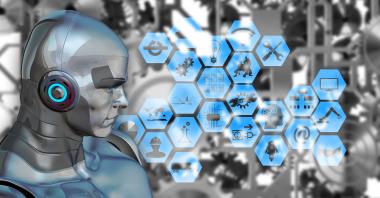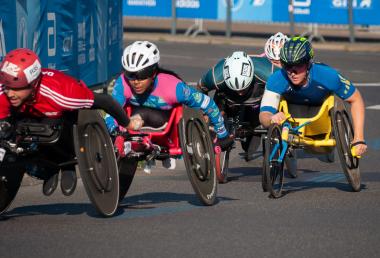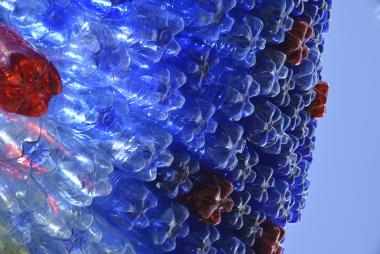Individual plastic budget - Fraunhofer UMSICHT presents study results
When plastics enter the environment, this brings with it many negative effects: these range from suffocating living organisms to transfer within the food chain and physical effects on an ecosystem. In addition, there are dangers from the release of additives, monomers and critical intermediates of metabolic processes, the metabolites.
How great the long-term impact of plastic emissions actually is, is not yet clear at the present time. In order to create a political decision-making basis for dealing with plastic emissions, researchers from Fraunhofer UMSICHT and the Ruhr University Bochum have therefore developed a budget approach and an LCA impact assessment methodology in the "PlastikBudget" project from December 2017 to the end of August 2021. The researchers have now completed the project. The result: When driving a car, a person emits more than half of their individual plastic emission budget through tire wear.
How big is the long-term impact of plastic emissions?
Six percent of global petroleum consumption goes to the plastics industry - and the trend is rising. While the plastics industry is an important economic factor in many countries, more and more plastic waste ends up in soils and oceans. Mostly in the form of highly mobile, small to large plastic fragments, plastic emissions can no longer be recovered from the environment. At the same time, the long-term effects of plastic in the environment are hardly predictable.
Due to the global and cross-generational dimension of the problem, it is important that science, industry and consumers work together to find a solution. One goal of the joint project PlastikBudget is therefore to quantify today's plastic emissions and to derive a plastic emissions budget. On this basis, the researchers can formulate quantitative emission targets that can be used to legitimize political decisions. In particular, the path from empirically verified data and normative values to a concrete emissions budget forms the core objective of the project.
From research to per capita emissions budget
Starting with a basic research on plastic quantities in the environment, the project addresses two major topics: The development of a budget approach and the development of an impact assessment method that can be used in life cycle assessments to consider potential environmental impacts of plastic emissions. Participatory formats complete the project. In this way, the results are anchored in political and scientific discourse. In the course of the project, the researchers will answer the following questions: What quantities of plastic are currently being discharged and what quantities have already accumulated? What quantities of plastic in the environment are still acceptable? How long does it take for plastics to degrade in real environmental compartments? How are the risks posed by different plastic emissions adequately represented? Finally, from the answers, they calculate a value for current emissions and what they consider to be an acceptable emissions budget.
250 million tonnes of PPE for 7.8 billion people
To measure plastic pollution, the researchers in the PlastikBudget project have developed the persistence-weighted plastic emission equivalent (PPE for short). This represents a virtual mass that takes into account the period of time until a specific plastic emission is degraded, e.g. in soil, freshwater or seawater. Relevant properties for this are the location of the emission, the material type, the shape of the plastic emission as well as the size of the emitted plastic part and the final environmental compartment in which the plastic remains. In the case of plastics that degrade completely within one year, the plastic emission equivalent corresponds to the real mass. If the degradation time is longer, it increases accordingly.
"Based on the thesis that the total amount of plastics already accumulated in the environment today has just reached a critical quantity, we were able to calculate a global plastic emission budget of 250 million tonnes of PPE," explains Jürgen Bertling, project manager of the project and scientist at Fraunhofer UMSICHT. "If each of the 7.8 billion people is allocated the same emission rights, this results in an individual budget of 31.9 kilograms of PPE per person and year."
Driving consumes half of the individual plastic budget
However, tire wear from driving alone corresponds to a plastic emission equivalent of 16.5 kg PPE per year and thus consumes more than 50 per cent of an individual's budget. Even waste from ten coffee-to-go disposable cups would consume 13.5 kg of PPE per year, more than a third of one's budget. "This is because the plastics used in disposable cups are more difficult to degrade than the rubber in the tire," explains Jan Blömer from Fraunhofer UMSICHT, who played a key role in developing the calculation methodology. The consumption of a coil of polyamide for a lawn trimmer, which releases microplastics when used, also weighs in considerably at 5.1 kilograms of PPE. Microbeads in cosmetics or the one-time sanding of a front door, on the other hand, consume significantly less of the individual emissions budget with 1.1 kg PPE and 0.5 kg PPE, but are still quite relevant in the overall balance.
Many other everyday activities also lead to plastic emissions. Nevertheless, the researchers show that the calculated budget limits can be met in various scenarios. However, such a scenario also entails considerable effort and massive changes in the way we deal with plastics today. One possible scenario to meet the budget would be a reduction of emissions by more than 50 per cent, if at the same time at least 50 per cent of all emissions consisted of readily degradable plastics.
Further work on accounting for plastic emissions in life cycle assessments
The persistence-weighted plastic emission equivalent developed in the PlastikBudget project could also represent a new impact category in life cycle assessments in the future. "With the help of factors that reflect the persistence of plastics in the environment, it will be possible in future to compare different product alternatives in terms of their plastic emission footprints," says Dr Daniel Maga, who is coordinating the corresponding further development of the life cycle assessment methodology at Fraunhofer UMSICHT. A corresponding exchange with companies is taking place here. However, implementation in the life cycle assessment methodology and the associated software solutions requires broad acceptance in the scientific community and must be prepared in corresponding standardisation committees.
The project is part of the research priority "Plastics in the Environment" (PidU) of the Federal Ministry of Education and Research (BMBF), in which 18 collaborative projects with around 100 partners from science, industry, associations, municipalities and practice want to clarify fundamental questions about the production, use and disposal of plastics. The research focus "Plastics in the Environment - Sources, Shrinking, Solutions" is part of the Green Economy flagship initiative of the BMBF framework programme "Research for Sustainable Development" (FONA3).
Fraunhofer Institute for Environmental, Safety and Energy Technology UMSICHT







